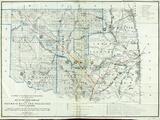
Faux George Washington peace medal / United States
Essay/Description
A pewter medal made for the Chouteau fur trade company with a bust of George Washington and the words, “George Washington, the Founder of Our Country” on the front. On the back, there is a peace pipe, a tomahawk, clasped hands, and the words, “Peace and Friendship.” government in 1844.
The Chouteau family moved upriver from New Orleans to start a trading post on the banks of the Mississippi River. Their tiny post became the city of St. Louis. For many decades, each generation of Chouteau men traded goods for furs, primarily among the Osage. Chouteau trading posts were located not only in Missouri but also in Arkansas and Oklahoma. Eventually, their posts reached nearly to the Canadian border.
These pieces were made to look like official government medals which the Indians accepted. However, these medals were cast in pewter so as not to compete directly with the federal government. However, in 1844, the Secretary of War banned their medals. It isn’t known how many were made or distributed but today, they are very rare.
Silver peace medals were given to influential Native Americans as a symbol of friendship and allegiance with the United States government. Medals were given on important occasions, like the signing of a treaty, and then only to very influential members of the tribe. The medals held even greater importance than normal during times of war or tension, particularly between the US and Great Britain. The countries would compete for the loyalty and friendship of the tribes, and a chief trading in British medal for a US one signified a change in loyalty (Prucha 2000, xiv). Gradually, the medals original meaning diminished, and they were given as rewards for good behavior. The practice was discontinued in the late 1800s.
Native Americans placed great significance on the peace medals and viewed them not only as a sign of friendship, but of power. A suggested reason for this is the connection they saw between these medals and the shell gorgets worn and decorated to represent power. The gorgets, which typically only chiefs and the elite would wear, held a supernatural power source. Images on a gorget gave the wearer the power of what the image represented. Similarly, to the Native Americans, the image displayed on the medal, the head of the president or king, gave the wearer the leader’s power (Reilly III 2011).






